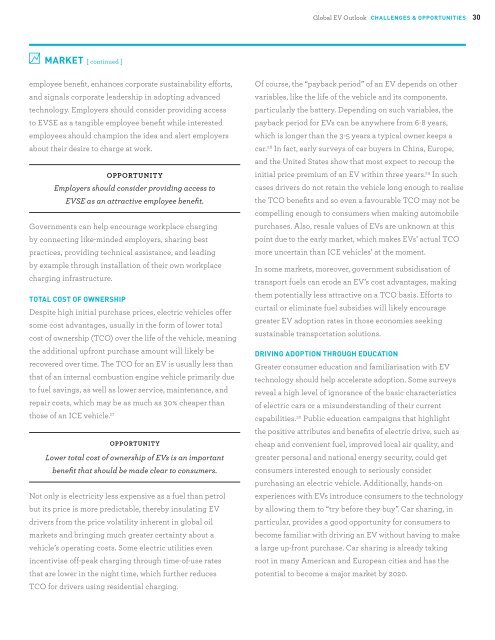Understanding the Electric Vehicle Landscape to 2020 - IEA
Understanding the Electric Vehicle Landscape to 2020 - IEA
Understanding the Electric Vehicle Landscape to 2020 - IEA
Create successful ePaper yourself
Turn your PDF publications into a flip-book with our unique Google optimized e-Paper software.
Global EV Outlook CHALLENGES & OPPORTUNITIES<br />
30<br />
MARKET [ continued ]<br />
employee benefit, enhances corporate sustainability efforts,<br />
and signals corporate leadership in adopting advanced<br />
technology. Employers should consider providing access<br />
<strong>to</strong> EVSE as a tangible employee benefit while interested<br />
employees should champion <strong>the</strong> idea and alert employers<br />
about <strong>the</strong>ir desire <strong>to</strong> charge at work.<br />
OPPORTUNITY<br />
Employers should consider providing access <strong>to</strong><br />
EVSE as an attractive employee benefit.<br />
Governments can help encourage workplace charging<br />
by connecting like-minded employers, sharing best<br />
practices, providing technical assistance, and leading<br />
by example through installation of <strong>the</strong>ir own workplace<br />
charging infrastructure.<br />
TOTAL COST OF OWNERSHIP<br />
Despite high initial purchase prices, electric vehicles offer<br />
some cost advantages, usually in <strong>the</strong> form of lower <strong>to</strong>tal<br />
cost of ownership (TCO) over <strong>the</strong> life of <strong>the</strong> vehicle, meaning<br />
<strong>the</strong> additional upfront purchase amount will likely be<br />
recovered over time. The TCO for an EV is usually less than<br />
that of an internal combustion engine vehicle primarily due<br />
<strong>to</strong> fuel savings, as well as lower service, maintenance, and<br />
repair costs, which may be as much as 30% cheaper than<br />
those of an ICE vehicle. 27 OPPORTUNITY<br />
Lower <strong>to</strong>tal cost of ownership of EVs is an important<br />
benefit that should be made clear <strong>to</strong> consumers.<br />
Not only is electricity less expensive as a fuel than petrol<br />
but its price is more predictable, <strong>the</strong>reby insulating EV<br />
drivers from <strong>the</strong> price volatility inherent in global oil<br />
markets and bringing much greater certainty about a<br />
vehicle’s operating costs. Some electric utilities even<br />
incentivise off-peak charging through time-of-use rates<br />
that are lower in <strong>the</strong> night time, which fur<strong>the</strong>r reduces<br />
TCO for drivers using residential charging.<br />
Of course, <strong>the</strong> “payback period” of an EV depends on o<strong>the</strong>r<br />
variables, like <strong>the</strong> life of <strong>the</strong> vehicle and its components,<br />
particularly <strong>the</strong> battery. Depending on such variables, <strong>the</strong><br />
payback period for EVs can be anywhere from 6-8 years,<br />
which is longer than <strong>the</strong> 3-5 years a typical owner keeps a<br />
car. 28 In fact, early surveys of car buyers in China, Europe,<br />
and <strong>the</strong> United States show that most expect <strong>to</strong> recoup <strong>the</strong><br />
initial price premium of an EV within three years. 29 In such<br />
cases drivers do not retain <strong>the</strong> vehicle long enough <strong>to</strong> realise<br />
<strong>the</strong> TCO benefits and so even a favourable TCO may not be<br />
compelling enough <strong>to</strong> consumers when making au<strong>to</strong>mobile<br />
purchases. Also, resale values of EVs are unknown at this<br />
point due <strong>to</strong> <strong>the</strong> early market, which makes EVs’ actual TCO<br />
more uncertain than ICE vehicles’ at <strong>the</strong> moment.<br />
In some markets, moreover, government subsidisation of<br />
transport fuels can erode an EV’s cost advantages, making<br />
<strong>the</strong>m potentially less attractive on a TCO basis. Efforts <strong>to</strong><br />
curtail or eliminate fuel subsidies will likely encourage<br />
greater EV adoption rates in those economies seeking<br />
sustainable transportation solutions.<br />
DRIVING ADOPTION THROUGH EDUCATION<br />
Greater consumer education and familiarisation with EV<br />
technology should help accelerate adoption. Some surveys<br />
reveal a high level of ignorance of <strong>the</strong> basic characteristics<br />
of electric cars or a misunderstanding of <strong>the</strong>ir current<br />
capabilities. 30 Public education campaigns that highlight<br />
<strong>the</strong> positive attributes and benefits of electric drive, such as<br />
cheap and convenient fuel, improved local air quality, and<br />
greater personal and national energy security, could get<br />
consumers interested enough <strong>to</strong> seriously consider<br />
purchasing an electric vehicle. Additionally, hands-on<br />
experiences with EVs introduce consumers <strong>to</strong> <strong>the</strong> technology<br />
by allowing <strong>the</strong>m <strong>to</strong> “try before <strong>the</strong>y buy”. Car sharing, in<br />
particular, provides a good opportunity for consumers <strong>to</strong><br />
become familiar with driving an EV without having <strong>to</strong> make<br />
a large up-front purchase. Car sharing is already taking<br />
root in many American and European cities and has <strong>the</strong><br />
potential <strong>to</strong> become a major market by <strong>2020</strong>.
















